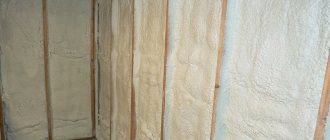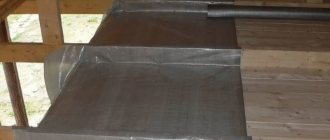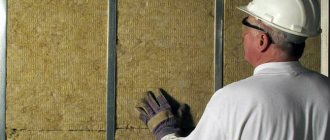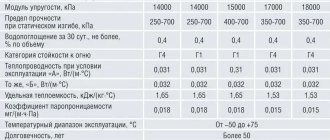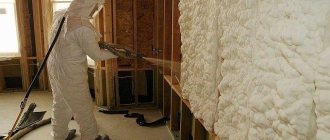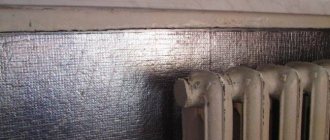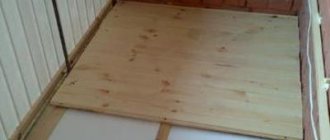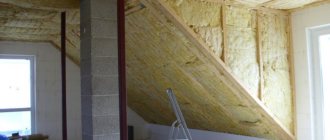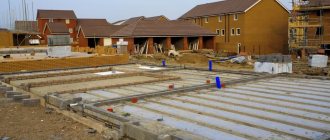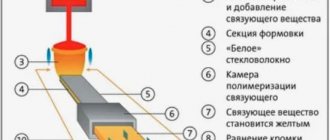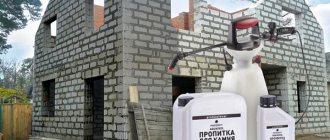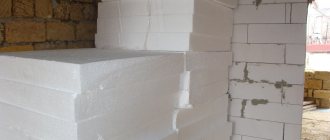10/07/2019 There are many skeptics who claim that insulating a house or apartment from the inside is not the best option. But, in some cases, it is simply not possible to insulate the walls from the outside. Internal thermal insulation is becoming practically the only way that can provide a home with warmth and comfort and reduce energy consumption.
How to insulate a house from the inside, what features of the process need to be taken into account - we tried to cover the topic to the maximum. In the publication you will find the following:
- Features of internal insulation of a house: what is important to know first;
- Preparing the room for internal insulation;
- Insulation of walls from the inside with polystyrene foam; Selection of expanded polystyrene for internal insulation;
- Installation of extruded polystyrene foam for internal insulation;
- How PIR boards are installed for internal insulation;
- Selection of mineral wool for internal insulation;
Features of internal insulation of a house: what is important to know first
The main and hidden “enemy” of internal insulation is condensation. The air around us contains vapors in different concentrations. As a rule, in residential premises the concentration of vapors is often high. This is due to cooking in the kitchen, using bathrooms, watering flowerpots, wet cleaning and other reasons. Excess moisture is always removed through ventilation ducts and open windows. But in addition, they penetrate into the walls due to the porosity of the materials. When passing the wall, the vapor molecules necessarily collide with a conventional line, at which they turn into a liquid state - they condense. This line is called the "Dew Point".
With internal insulation, the dew point will always be located immediately behind the installed thermal insulation - that is, on the inner surface of the wall. When steam hits the wall, it forms condensation and moistens the wall material. The consequences of this are sad: immediately behind the insulation, a zone is formed with ideal conditions for the growth of bacteria, fungi, and mold. Thus, the premises may even become dangerous for living.
Based on what was described above, we conclude that the main task with internal insulation is to do everything possible to prevent contact of moist air with the dew point. That is, task No. 1 is to protect the inner surface of the wall from the slightest contact with steam . And this can be done quite simply. You need to do three things:
- follow the insulation installation technology;
- be sure to install a vapor barrier;
- choose the right material for wall insulation.
The essence and problems of internal insulation
The concept of “insulation inside” means covering the surface of the walls with special insulating materials.
Many experts are against indoor insulation. In their opinion, it is better to use internal insulation only as a last resort, because this method of thermal insulation causes serious problems:
- The walls do not warm up . The lack of internal insulation allows warm air from the room to pass through the walls and warm them. After covering the inside of the wall with insulating material, warm air does not have the opportunity to escape outside. The walls of the room do not heat up. Moreover, cracks begin to appear on them over time.
- Condensation _ Condensation appears under insulating materials after a minimum period of time. Its appearance will reduce the thermal insulation properties and also promote the formation of fungus. Ultimately, this will lead to the gradual destruction of the wall.
- "Steals" the area . Unfortunately, experts have not yet come up with thermal insulation materials that would be thin. Most insulation materials have a thickness of 5 cm or more. And this significantly reduces the total area of the room.
We advise you to seriously think about the above problems, because insulating a house from the inside is not cheap. And if problems arise, you will have to spend money to fix them.
About building materials
If you nevertheless decide on internal thermal insulation, you need to familiarize yourself with all the methods of such insulation.
There are 3 of them:
- Foam insulation;
- Pasting mineral wool on the walls;
- Insulation with wood fiber boards.
Polystyrene foam and mineral wool are also used to insulate walls from the outside. The laying of these materials outside and inside is carried out using the same technology. The use of wood fiber boards requires special knowledge.
Covering walls with mineral wool and foam plastic
Experts recommend laying polystyrene foam and mineral wool in 2 ways:
- Standard . This option is no different from insulating the outside of the walls. You need to first clean the surface, secure the material, reinforce it and decorate it.
- Using a frame. First you should make a frame out of metal or wood. Then the insulation process is carried out in the same way as described in method 1. The use of a frame allows you to avoid the formation of condensation, because the material is not “tightly” attached to the wall.
Experts also advise thinking about creating removable panels. This will give you the opportunity to monitor the appearance of condensation and take the necessary protective measures.
Fiberboards
Fiberboard (Fiberboard) is most often used to finish the outside of walls.
The advantages of this material are obvious:
- It retains heat excellently and also absorbs noise.
- The slabs are treated with toxic agents, so insects and rodents will not settle in your home.
- Fiberboard perfectly tolerates changes in moisture and temperature.
- Any tools can be used to cut slabs.
- Easy to install. All you need to do is nail the slabs with nails at least 3.5 cm long. It is best to fasten the nails in a checkerboard pattern. To nail 1 sheet, as a rule, 16-18 nails are used. Fiberboard can be glued to plastered walls using mastic or PVA.
- Possibility of laying wiring using special grooves.
The use of fiberboard boards does not guarantee that condensation will not appear on the walls in the future or other difficulties will arise.
Important criteria for choosing material for insulating walls from the inside
When choosing a thermal insulation material, experts advise remembering the following criteria:
- Environmental friendliness . If the material contains toxins, they will begin to be released into the room, causing harm to residents.
- Fire safety . The insulation must be resistant to high temperatures.
- Durability . The insulation should not quickly lose its shape and properties.
- Low thermal conductivity . Good insulation keeps heat indoors rather than leaking it out. The lower the thermal conductivity, the thinner the thermal insulation sheets you need.
- Moisture resistance . Choose a material that does not absorb moisture well.
When preparing for internal wall insulation, you will need to purchase other materials.
What else will you need to buy?
In addition to thermal insulation material, you will need:
- Timber . You cannot do without it if mineral wool is used for insulation. The width of the material should be slightly greater than the thickness of the insulation. If you decide to use polystyrene foam, then use special glue instead of timber.
- Reiki . They will be needed to attach the vapor barrier.
- Vapor barrier . To ensure that the walls of the room can “breathe,” experts recommend using a special membrane that allows air to pass through.
- Finishing material. If you are going to create a frame for insulation, then buy drywall or lining. You will also need wallpaper and putty to make the thermal insulation material aesthetically pleasing.
- Consumables. You will not be able to attach polystyrene foam and mineral wool without plastic dowels with a wide head.
- Antiseptics. To reduce the likelihood of mold or mildew, treat the insulation with these products.
- Waterproofer . Experts advise purchasing a “breathable” membrane.
When all the necessary materials have been purchased, it is time to begin the insulation process.
Preparing the room for internal insulation
Like any other construction project, internal insulation begins with preparation. At this stage you need to do the following:
- Eliminate weak and defective areas;
- Perform antiseptic surface treatment.
First of all, you need to assess the general condition of the walls, the presence of cracks, chips in the plaster, and weak spots. It is recommended to eliminate all defects found. And the point here is not so much the quality of insulation, but rather the improvement of the performance characteristics of the walls. Correcting defects in a timely manner will prevent them from aggravating the situation in the future. After all, if the crack spreads further and the plaster falls off, then to fix this problem you will need to dismantle a large section of the insulation and redo everything again. This is not only unpleasant, but also expensive, time-consuming, and labor-intensive.
It is imperative to check the walls for existing mold and fungi before insulating them from the inside. Under no circumstances should you carry out further work until the problem has been completely eliminated. If fungal infections are found, we recommend removing the plaster in this area completely - to the base of the wall. Next, you need to treat the area with a special antifungal chemical 2-3 times. There should be no visible marks on the surface after treatment.
For pre-treatment of surfaces in order to destroy existing lesions, we recommend using the following compositions:
- Antiseptic Anti-mold Propitex 1l. A composition that contains active substances to destroy mold on wood, stone, cement and other substrates. Can be used to effectively remove spores, yeast and other types of fungi.
- Dufa mold removal solution. Instant action composition. Due to the inclusion of chlorine, it is characterized by the instant destruction of fungi and mold. Penetrates well into porous wall materials, due to which it is able to remove damage in the structure. When using, it is recommended to thoroughly ventilate the room and use personal protective equipment for hands and respiratory organs.
The next stage is priming the wall with a composition with antiseptic additives. This must be done regardless of whether fungal infections were found or not. In the future, such a composition will effectively prevent the formation of mold under the insulation. You should choose a primer only with special antiseptic properties and a long-lasting effect. For example, suitable:
- Primer EK GS400 ANTISEPTIK. Composition for porous surfaces of plasters and concrete. Penetrates deeply into the structure, strengthens, removes dust from the surface and binds small particles. Reduces water absorption and improves strength. Has a long-lasting antiseptic effect with protection against fungi and mold.
- Antiseptic Anti-mold Propitex 5 l. This composition has a long-term biocidal effect, due to which it can be used for subsequent insulation.
After the primer composition has completely dried, you can begin subsequent work. The technology for installing insulation will depend directly on the material used for wall insulation. In particular, this can be thermal insulation using polystyrene foam or mineral wool.
Thermal insulation procedure for walls
Before you insulate your apartment, you need to understand all the intricacies of the process and prepare. Whatever material is chosen, insulation has some important steps that are carried out in a strict sequence.
Preparatory work
Since you can insulate the wall of an apartment from the inside yourself, you must first prepare for the work. Moreover, you need to prepare not only the base, but also the insulation itself. The stages of work are as follows:
- Cleaning the surfaces of walls and partitions from debris, dust, and previous finishing. To remove wallpaper, just wet it and scrape it off with a spatula. Mechanical or chemical means are used to remove paint.
- Elimination of irregularities. Small flaws can be removed using putty. For large uneven areas you will have to resort to installing drywall. To attach it, the construction of a frame made of metal profiles is required. This leveling method steals usable space, but allows you to quickly prepare the walls and provide additional insulation.
- Treating the walls from the inside with an antiseptic. The product will help protect the base from the formation of fungus and mold if the room is operated in conditions of increased dampness. The mixture is selected taking into account the technical characteristics of the base, method of application, as well as operating conditions of the room.
- Applying primer. It is applied in 2 layers. In this case, the next one should be applied only after the previous one has completely dried.
- Waterproofing the wall. Here you will need high-quality polyethylene film. You can fasten it with a stapler. The joints must be taped with masking tape. The film must overlap the corners, floor and ceiling. The material sheets should also overlap each other by 10-15 cm.
Insulating walls from the inside in a corner apartment involves additional treatment of the wall-to-ceiling connection points and internal corners.
Fastening
To insulate a cold wall, a preliminary selection of material and tools is carried out. High-quality insulation involves creating a “pie” from several layers of different products, each of which provides certain properties. The work has the following stages:
- Making the frame. It is required for internal insulation with bulk materials, when it is necessary to level the base or when there is no need to plaster the base. The frame also allows you to protect fragile types of insulator from mechanical damage. For its manufacture, a metal profile or wooden slats are used. They can be attached to the base with self-tapping screws or using dowels. The width of the material determines the distance between the slats.
- Fixing the insulation. It is screwed with self-tapping screws or dowels and nails with round heads. The joints or gaps between parts of the insulation are filled with polyurethane foam.
Another method of insulation is gluing the material. This requires careful preparation of the base and its leveling. The walls inside the apartment, as well as the insulating material, are coated with glue. Next, the product adheres tightly to the surface being treated. It takes 2-3 days for the composition to dry. Additionally, a mechanical fixation method is used.
In order to correctly and accurately attach the material, the inner surface of the base is marked. It is not worth covering the entire wall with glue at once. If a sprayed material is selected, then the work is carried out in accordance with the instructions written on the packaging.
Final works
The decision on how best to insulate an apartment in a panel house or brick structure is made individually, taking into account the capabilities of the owner and the technical parameters of the structure. After laying the insulation, a hydro- and vapor barrier film is laid on top of it. It is fixed with slats and brackets. The edges of the film are laid on adjacent surfaces, where they are secured with sealant.
Now you can begin finishing the base. For wallpapering, an additional layer of plasterboard is installed. The simplest finishing method is plastering and puttying the walls. Paint, tiles, and plastic panels are often used as decorative materials.
Insulation of walls from the inside with polystyrene foam
Expanded polystyrene is objectively the most acceptable type of thermal insulation material for internal wall insulation. At the same time, only a special type of it should be used for internal thermal insulation - extruded polystyrene foam . The peculiarity of this building material is as follows:
- Increased density. Extruded polystyrene foam slabs are produced by the extrusion method - squeezing raw materials through a narrow nozzle of an extruder (special equipment) under pressure. The material forms a dense, airless structure and is characterized by increased strength, rigidity, and geometric accuracy.
- Almost zero vapor permeability. Installed as thermal insulation, XPS foam boards allow virtually no vapor to pass through them. Thus, this particular insulation is rational and suitable for internal thermal insulation. It becomes a natural barrier between the internal surfaces of the wall and the humid air in the room.
- Thermal insulation properties. Extruded polystyrene foam is characterized by an ultra-low thermal conductivity coefficient of about 0.037-0.041 W/m*K. It demonstrates excellent resistance to heat transfer, due to which the maximum insulation effect is achieved with a small thickness. At the same time, losses of useful volume from internal insulation are minimized.
- Low price. The material has an excellent cost-performance ratio.
Selection of extruded polystyrene foam for internal insulation
Extruded polystyrene foam boards differ in thickness and type of edge. For internal insulation, choose slabs with the following thickness:
- 2-3 cm for a small room area;
- 5 cm in large rooms;
- 10 cm when insulating a loggia balcony that is part of a living space.
The edge of the slabs is an important nuance that is always taken into account when choosing internal thermal insulation. Foam plastic slabs with a straight edge form a small gap when they meet, but still a gap. It is a natural bridge through which cold enters the room and vapor passes under the insulation.
For internal insulation, we recommend using only slabs with a locking joining system - L-edge . Due to this configuration, the thermal characteristics of the heat insulator are improved and vapor permeability is minimized.
Products suitable for internal insulation of houses and apartments include:
- TECHNONICOL CARBON ECO 1180x580x30 mm. Characterized by an optimal ratio of thickness and thermal insulation. Suitable for rooms with a small area, as it practically does not “eat up” square meters. Equipped with L-edge, has high heat transfer resistance.
- TECHNONICOL Technoplex 1180x580x50 mm. Equipped with excellent strength and thermal characteristics. It has an optimal thickness for insulating medium and large rooms and balconies.
- TECHNONICOL CARBON ECO 1180x580x100 mm. The most effective thermal insulation is achieved when installing such material. Equipped with an L-edge, it can be used for insulating open balconies and loggias, large rooms.
Installation of extruded polystyrene foam for internal insulation
Installation of this type of insulation is possible in two ways - using polystyrene foam glue or using dowels.
Dowel mounting:
- Fastening with dowels is carried out after preliminary arrangement of the vapor barrier. A metallized substrate, membrane or overlapping polyethylene film is installed on the wall.
- The seams are taped with aluminum tape to prevent steam from getting under the film.
- The slabs, pre-cut to size, are installed on the wall and fixed using plastic mushroom dowels with a plastic nail.
- The joints of the plates and the dowel heads are glued with aluminum foil.
- Finishing is carried out - plastering or cladding of gypsum boards.
Glue fastening:
- In this case, installing a vapor barrier is impossible, therefore, special attention is paid to the joints.
- You can use dry glue for polystyrene foam, for example, EK THERMEX or Yunis Teplomontazh. It is also permissible to use special glue in cylinders in the form of low-expansion foam.
- For better adhesion, the internal surfaces of the slabs are processed with a float until a rough surface is obtained.
- The glue can be applied evenly to the wall or in “bloops” on the slab along the edges and in the center.
- The plate is placed against the wall and pressed down. Flatness and level are checked at the same time.
- The joints are taped with aluminum tape.
- Finishing is in progress.
There is a combined method of fastening using glue and dowels. But it is rational for external insulation of a room. The foam inside will not experience increased stress. Therefore, it is enough to choose one of the options.
Insulation of walls using foam
To insulate the exterior of the house facade, special dispersed foams are also used. Such foam must be applied using spray devices. An externally insulated wall using foam will have similar thermal insulation properties to a wall insulated with mineral wool or polystyrene. When combined with oxygen, such foam changes in size, increasing its volume several times. This product is very good for use in hard-to-reach areas, and the condition of the facade will be no worse than when finishing with other insulation materials. After the foam has completely dried, the walls become completely breathable. Before using this method of insulation, you must carefully study the instructions for using the foam. Today on the construction market there is a large abundance of insulating materials for house facades. Which one to choose in order to create favorable and comfortable living conditions in your apartment and prevent heat loss is up to you to decide.
PIR insulation is a modern analogue of extruded polystyrene foam
PIR insulation appeared on the market relatively recently. Therefore, they need to be considered separately. This heat insulator is a three-layer material consisting of an inner layer of polyisocyanurate foam, covered on both sides with aluminum reflective foil.
In fact, PIR (or polyisocyanurate foam) is a special type of polyurethane with a rigid structure, ultra-low thermal conductivity and increased strength parameters. Due to this, it has successfully proven itself as a heater for internal thermal insulation of any premises, from bedrooms to balconies and loggias.
A special property of this insulation is the additional reflection of heat back into the room due to the foil. Thus, the thermal conductivity coefficient decreases to an unprecedented 0.022 W/m*K, water absorption is only 1% (this is when immersed in water for a day). But the main thing is that the vapor permeability of PIR insulation is reduced to zero due to the same foil coating.
For internal insulation, an excellent solution would be to choose materials such as:
- LOGICPIR universal insulation L 1190x590x50 mm. It has the optimal thickness for medium and large rooms, equipped with an L-edge to prevent the formation of cold bridges.
- Insulation LOGICPIR Balcony L 1185x585x30 mm. It is used on the bottom of small unheated balconies. L-edge present.
- Insulation LOGICPIR Balcony L 1190x590x50 mm. Recommended for insulating a heated balcony, as well as a balcony that is part of a living space.
How PIR boards are installed for internal insulation
The aluminum surface of Pir-plates does not allow high-quality fixation of the insulation using the traditional adhesive method. In this case, the technology with plastic mushroom dowels with plastic nails is used.
The very essence of the technology does not differ from the fastening of polystyrene foam described above. After completing the installation of the last slab, the joints are glued. The gaps between the floor and the slab can be filled with polyurethane foam. Next comes finishing. Instead of dowels, you can use wood sheathing. The beam presses the insulation against the wall, after which the cladding is carried out with panels, lining, gypsum board and other materials. An example of installation can be seen in the photo instructions:
Insulation of apartment walls from outside
Since properly insulating an apartment inside is not always effective, if possible, it is better to insulate the walls of an apartment building from the outside. The advantage of this type of insulation is:
- no reduction in usable space inside the rooms;
- reducing the humidity level in the apartment;
- no need to move furniture or cover it with something;
- protection of walls from freezing throughout their entire thickness, which eliminates the appearance of cracks or other damage.
Expanded polystyrene (penoplex) is most often used for external insulation of apartments. The surface of the facade is pre-cleaned of debris, dust, and moss. It is advisable to prime it additionally. It is better to start laying out sheets from the top point. In a panel house, the slab should protrude 5 cm or more beyond the panel seam line. If there are brick walls, polystyrene foam protrudes beyond them.
“Fungi” are used to fix the slabs. Each sheet requires 5 fasteners. After the sheets are secured, the joints between them are blown with foam. Next, they are additionally taped with construction tape. This arrangement will avoid cracking of the material if it shrinks.
If we insulate the wall with basalt wool, then a ventilation gap is created between the insulator and the wall. This will allow the material to retain its original shape for a long time. Excess moisture is removed through air flows, so it does not accumulate in the insulation.
Before applying the decorative layer, the surface is reinforced with a plastic mesh. The product is attached using the same glue that was used to fix the polystyrene foam. You need to attach a reinforcing corner to the corner. It will align the line and protect the material from mechanical damage.
Insulating a house from the inside with mineral wool
Mineral wool is not an optimal thermal insulation material for internal insulation. There is only one reason for this - cotton wool allows steam to pass through perfectly. Because of this, described at the beginning of the article, the dew point shifts from the inner surface of the wall into the insulation itself. Condensation can accumulate in it, thermal performance deteriorate, and mold and mildew can form. However, it is possible to use mineral wool for internal insulation if all technological nuances are observed.
Choosing mineral wool for internal insulation
Mineral wool should be selected based on criteria such as thickness and environmental friendliness. It is possible to use rolled wool, which is cut to the required length directly during installation. Also, such products are produced in slabs. For internal insulation, 50 mm is the optimal thickness at which good insulation is achieved without significant loss of the usable volume of the room.
Example of suitable types of mineral wool:
- Ecoroll Plate 40. It has a relatively small thickness of 50 mm and does not contain phenol resins. Recommended by the manufacturer for internal insulation, including walls.
- TeploKNAUF For COTTAGE Thermo Plate is a modern insulation material from a well-known manufacturer, the features of which are: low thermal conductivity (0.37 W/m*K) and excellent water-repellent properties due to impregnation of the fibers with a special composition. In addition, this board has a special fiber arrangement structure, due to which sound absorption significantly increases. Thus, this insulating material is recommended for insulating the inside of walls, floors, and attics in houses located in noisy areas.
Basalt wool for internal insulation
Separately, attention should be paid to a type of mineral insulation such as basalt wool. The peculiarity of this heat insulator is not only its excellent thermal insulation properties and environmental friendliness, but also its high fire safety. Basalt fiber is obtained from natural stone. Accordingly, such a material has excellent resistance to open flames.
The fire resistance of basalt wool is an important nuance that must be taken into account when insulating the walls of wooden houses, country houses, and baths. In this case, we especially recommend choosing certified products.
These could be slabs:
- Rockwool Light Butts SCANDIC. Products that are designed specifically for insulating residential buildings, apartments and cottages. It is characterized by compliance with environmental standards (has low resin emissions, safe in residential areas). Flexi technology ensures simple installation with filling of gaps in the frame due to the spring properties of the insulation. The material is biostable - bacteria and mold do not form in it, and it is not a good habitat for insects or rodents.
- Rocklight insulation. Manufacturer TechnoNIKOL recommends using this insulation for internal thermal insulation from inside walls, floors, and attics. The material has low thermal conductivity (0.39-0.41 W/m*K). It is non-flammable, bioresistant, and due to special impregnations, it repels water well without accumulating it inside the structure. At the same time, the compressibility of the slab is 30%, which makes it possible to simplify the process of laying it between the joists and efficiently seal all the cracks and gaps.
Installation of mineral wool indoors
- A vapor barrier film must be installed around the perimeter of the wall.
- A frame made of wooden blocks is mounted on top of the vapor barrier. It is not recommended to use metal profiles. Metal perfectly transmits heat and will become an artificial bridge of cold
- !!! The metal frame should be used when arranging thermal insulation from the inside of objects with increased fire safety requirements together with basalt wool. These include wooden buildings: baths, saunas, etc. !!!
- The joints between the frame and the vapor barrier are taped with tape, since when fastened to the vapor barrier, a hole from the dowel is formed.
- Cotton wool is installed in the frame and carefully compacted to avoid the formation of any cracks.
- A second layer of vapor barrier is installed on top of the frame. This creates a double vapor barrier between the insulated wall and the room.
- The fastening points and joints of the vapor barrier are taped with aluminum tape.
- The frame is covered with preferred slabs - gypsum plasterboard, chipboard, etc.
If the technology is followed and only if a vapor barrier is installed in the insulation, a good result of internal thermal insulation can be achieved. On our own behalf, we would only like to add that insulating a house or apartment from the inside is, rather, an extreme and necessary measure. It is recommended to use it only if it is impossible to install thermal insulation from the outside. If such an opportunity exists, then we definitely recommend considering its implementation as a priority. We hope that the prepared publication will allow us to avoid mistakes and carry out internal insulation as efficiently as possible.
Types of insulation
Today, the market for thermal insulation materials is extensive, represented by various products. All of them are divided according to the place of their installation: outside the wall or inside the room.
Each of them has both disadvantages and advantages. When installing any of them, you must strictly follow the manufacturer's instructions.
When buying a heat insulator, you should pay attention to the following parameters:
- heat conductivity;
- air permeability;
- waterproofing properties;
- environmental Safety;
- fire resistance;
- operating time.
Using high-quality material, you can insulate a corner without any problems. What is the best insulation for walls inside an apartment? What is the best way to insulate walls from the inside?
Minvata
This heat insulator is the most popular; it is made from basalt fiber. It has excellent thermal insulation properties, allows good air ventilation, but does not tolerate excess moisture. This material has a high degree of fire safety and does not emit toxic substances when exposed to direct fire.
When installing mineral wool, special guides are used, and the installation process itself does not require much effort, since the material is light and elastic. Is it possible to insulate walls with it? But over time, these qualities can cause it to lose its shape.
The environmental component is also ambiguous - the material emits a small amount of harmful gases. Some people do not use it because of the significant weight gained during installation of the structure.
Polystyrene foam insulation
The name speaks about the process of its creation. That is, the material is created by foaming polystyrene under high pressure. The price of such material is quite affordable, it is easy to assemble and install, which makes it a popular heat insulator.
Expanded polystyrene has good thermal insulation properties, it is environmentally friendly and safe. It can be used for both interior and exterior work. It can be mounted on walls made of any material.
The process is quite simple and not labor-intensive. The advantages include its huge service life. But of course there are also disadvantages.
So, due to poor water permeability, condensation can accumulate on wooden walls, which leads to their destruction, and it is also highly flammable. The insulation of a concrete wall from the inside can be carried out perfectly using this material.
Extruded polystyrene foam
This material is the most popular insulation. It is elastic and easy to process. The disadvantages include the difficulty in joining sheets.
There is a material on sale in which the edge is made in the form of protrusions, which greatly facilitates installation work.
This heat insulator has good moisture resistance, it is lightweight, and convenient for installation work.
Use of polystyrene foam
This is an excellent material for insulating apartment walls. It contains more than 95% gas, so it is an excellent heat insulator.
It is distinguished by its low cost, excellent waterproofing, good soundproofing, and fire safety. Polystyrene foam is used at any temperature, being an environmentally friendly material.
Application of keramoizol
This is a relatively new material. It is sold in containers of various sizes, as it is a liquid material. Has excellent thermal insulation properties. Keramoizol is a durable, waterproof and vapor-tight product.
Might be interesting
Thermal insulation
How to insulate a roof from the inside and not make mistakes?
Thermal insulation
Roofing and drainage: heating rules
Thermal insulation
Insulated Swedish stove: pros and cons
Thermal insulation
Penoizol: self-production
During installation, several layers are applied, and for better thermal insulation - six. The layers are laid perpendicular to each other. This material has proven itself only from the best side. Its only and main disadvantage is its high price.
Penoizol insulation
Thermal insulation material - penoizol is a type of polyurethane and is used in the form of foam. The advantage is the quick installation of the material in a brick building. The foam hardens quickly, forming a layer of the required thickness of the heat insulator; there are no seams or joints.
Excellent thermal insulation and waterproofing properties, the material is non-flammable and environmentally friendly. But perhaps its main advantage is the low cost of work, almost two times less than when using conventional materials.
Using Astratek
Asstratek is a suspension; solid particles are represented by various polymers. To apply to the wall, use a spray gun or install it manually with a paint brush. Excellent insulation, just one centimeter of layer is similar to fifty centimeters of a mineral wool slab.
Does not take up the interior space of the room, forms a smooth, uniform surface that requires minimal processing for applying the cladding. The main limiting factor for large-scale application is its high cost.
How to insulate the walls in an apartment from the inside? It's up to you to decide.
Next, we will consider how to install insulation inside a panel house, as well as a monolithic one. How to insulate walls in an apartment from the inside?
